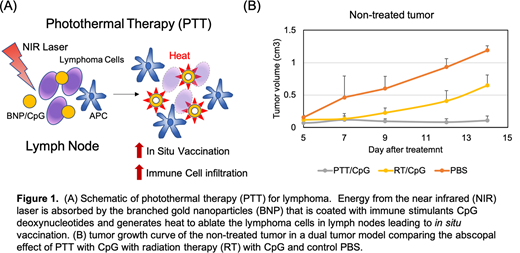Introduction: Although radiation therapy (RT) has limited clinical efficacy for advanced stage lymphoma, RT has been used as a method for in situ vaccination to generate an abscopal effect. Frank et al. combined low dose RT with class C CpG deoxynucleotides (CpGs) for the treatment of advanced stage indolent lymphoma (Cancer Discovery, 2018). CpGs are toll-like receptor 9 agonists and activates the innate immune system. The overall response rate was high (89.6%) in this trial but only 7 of 29 patients (pts) (24%) had partial response and 1 had a complete response (3%). Unlike external beam RT, photothermal therapy (PTT) using gold nanoparticles (AuNPs) can generate a strong in situ vaccination effect by heat ablation of tumors (Bear et al. PLOS One, 2013). (Figure 1A) The ablation induced increased CD8 T cell infiltration in non-treated tumors and dendritic cell maturation in the draining lymph nodes, but it also increased systemic immune suppression via increased myeloid suppressor cells (MDSCs) in a melanoma model. MDSCs differentiate into active macrophages when stimulated by CpGs. Other PTT methods have been evaluated in combination with check-point inhibitors with success in solid tumor murine models (Liu et al. Immunotherapy 2018; Chen et al. Nature Comm. 2016). Therefore, we hypothesized that PTT in combination with CpG can elicit a stronger the in situ vaccination effect compared with RT with CpG in a murine lymphoma model.
Methods: PTT is achieved by exciting branched AuNP (BNP) with a near infrared (NIR) laser (808nm). For the dual lymphoma model, A20 lymphoma cells in Matrigel were injected into the right flank of BALB/c mice to establish a primary tumor. Three days later, a secondary tumor was established in the left flank. When the tumor reached 5 mm in diameter, PTT with CpG (sequence 2395) or RT (10Gy) with CpG of the primary tumor were performed. Control groups included PTT without CpG, CpG only, BNP with CpG without PTT, and PBS. Sixteen days after PTT or RT, mice are euthanized and flow cytometry was performed on the primary tumor, secondary tumor, spleen, and draining lymph nodes and analyzed for T cells and dendritic cells (DC).
Results: Within 5 minutes after PTT, the temperature of the treated primary tumor reached almost 60°C. The primary tumor growth was inhibited for both RT/CpG and PTT/CpG treatment groups compared with the PBS control group. RT/CpGs treated primary tumors demonstrated re-growth 14 days (D14) after treatment while PTT/CpG treated tumors did not (p<0.01). For the non-treated secondary tumors, the RT/CpG group had delayed but continued tumor growth compared with the PBS control group, while PTT/CpG maintained tumor growth suppression, with the growth curves separating from the RT/CpG group as early as D9 (p<0.01). (Figure 1B) At the end of the study (D16), PTT/CpG group secondary tumors (344mm3) were almost a third of the size of RT/CpG group (958 mm3) (p=0.006). To further investigate the mechanism for the improved abscopal effect, we compared the differences in immune response between RT/CpG and PTT/CpG treatment groups. The amount of mature DCs (CD80+CD86+ in CD11c+ cells) in draining lymph nodes of both the PTT/CpG treated tumor (14.9%) and non-treated tumor (15.9%) were significantly higher than the RT/CpG group (8.78%, p=0.006; 10.2%, p=0.007, respectively). For the non-treated tumor, the PTT/CpG group had significantly increased amounts of CD8 (62.6%) T cell infiltration compared with the RT/CpG group (45.4%, p=0.022) as well as a higher CD8 to CD4 T cell ratio (1.91) compared with the RT/CpG group (0.95, p=0.042). Effector memory T cells in the secondary tumor (44.6%) and spleen (29.9%) for the PTT/CpG group was also higher than the RT/CpG group (23.2%, p=0.008; 21.2%, p=0.011, respectively). These changes suggest a significant exaggeration in T-cell education, which consequently results in suppression of lymphoma tumor growth.
Conclusion: Overall, we demonstrated as a proof-of-concept that PTT/CpG generated a stronger in situ vaccination effect when compared with RT/CpG therapy in lymphoma. In addition, we have described the immune responses after PTT in combination with CpG in a lymphoma model, showing increased dendritic cell maturation and T cell mediated immune response. Further studies including dosing schedule, combination therapy with check-point inhibitors or other immune based treatments will move this technology closer to clinical practice.
Gordon:Zylem Biosciences: Patents & Royalties: Patents, No Royalties.
Author notes
Asterisk with author names denotes non-ASH members.


This feature is available to Subscribers Only
Sign In or Create an Account Close Modal